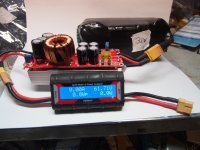Gionnirocket
Well-Known Unidentified Member
- Region
- USA
- City
- Y. O.
Perhaps if it could be implemented only when the voltage has fallen continuously below 48v... but then again adding even more complexity.
For me smaller lighter battery technology would be worth more. Then you could go 8+ in parallel
For me smaller lighter battery technology would be worth more. Then you could go 8+ in parallel
